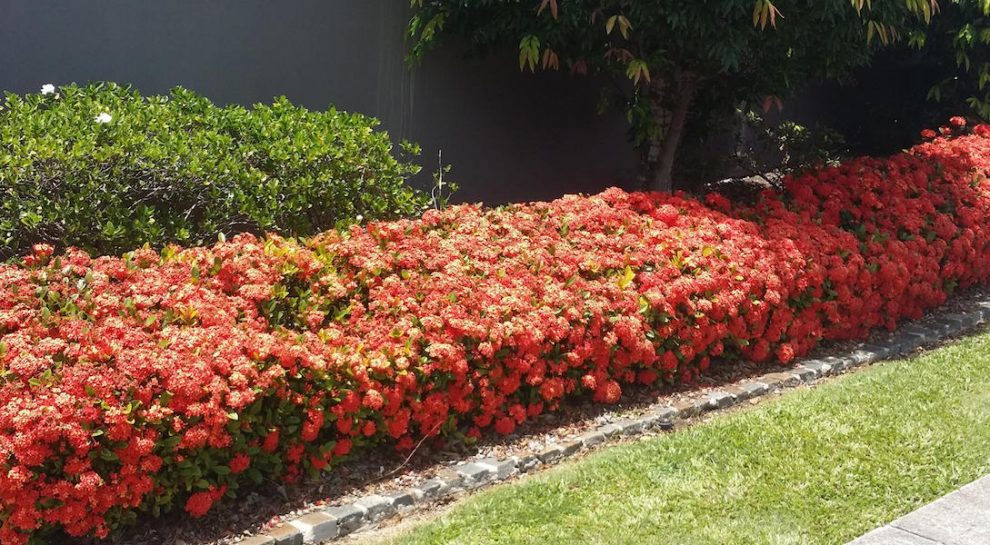Are you living in a subtropical climate? Kate Wall from Garden Drum has some great tips for choosing the perfect subtropical hedging.
When a friend was recently telling me all about her parterre garden in Armidale I was somewhat horrified for her, until she kindly pointed out what a very different climate Armidale is to where I am in Brisbane. I have never really enjoyed the look of those amazing parterre gardens, mazes and formal hedges of the grand European gardens. I am a professional gardener and they always bring to mind endless hours of hedge trimming resulting in aching arms and backs!!!!
That of course is where climate makes such a difference. And why you simply do not see those sort of hedges in the subtropics. I do know of a few gardens here that have lots of hedges but they also have trouble keeping gardeners.
Here in the subtopics (and even more so in the tropics!) things tend to grow – and grow and grow and grow. It is not uncommon for a duranta or murraya hedge to need trimming every 2 weeks for at least 5 months of the year while we have hot wet summers. This is probably why very untidy duranta and murraya hedges are very common here.
In the subtropics hedges are high maintenance, and poorly understood. My friend in Armidale only has to prune her parterre box hedges once a year. That sounds perfectly manageable – and shockingly unbelievable to us subtropical hedge growers! No wonder they are such successful garden features in cooler climates, it all makes sense now.
Duranta Sheena’s Gold is a bad choice for a subtropical hedge as it’s too fast growing, causing these ‘Vs’ to develop along the base
Probably the single biggest mistake most commonly made with hedges is as simple as plant choice. Hedge plants are chosen for being dense and fast growing but the overall mature height of the plant should also be taken into consideration. The bigger the difference between the natural height of the plant and the desired height of the hedge, the more work there will be in maintaining the hedge. Add a warm wet climate with accelerated growth rates and you have just tripled the amount of work required to keep the hedge to its desired height.
With modern plant breeding we no longer have any excuse for making this mistake! Lilly pillies have now been bred to be almost any shape and size you could possibly want, and they are just the tip of the iceberg when it comes to hedging plants. By choosing a plant that grows to the same height you want the hedge to be, you can eliminate an enormous amount of maintenance.
The same applies to any shrub or tree we plant in our gardens. I have a couple of clients who wonder why their cottage gardens never flower, in spite of the fact that they are planted full of wonderful flowering shrubs. These poor plants are so heavily pruned to keep them small and neat they never get the chance to flower.
While many wonderful old fashioned plants are only available in their original form, and we need to allow them to reach something approaching their natural height to enjoy abundant flowers, plant breeding has focused very much on dwarf forms of many garden favourites. This goes hand in hand with the shrinking size of modern gardens. We have smaller spaces to fit hedges and shrubs into, and yet we still have high expectations of those shrubs and hedges, and less time and interest in maintaining them.
Not only are these new dwarf varieties of old favourites great for small gardens, they can be very useful in hot climates if we want to live with neat gardens instead of small jungles. Ixora, Escallonia, Buddleia, Abelia, Raphiolepis, Loropetalum, Plumbago, Lagerstroemia and many others are all available and make great small shrubs for small gardens. You will be able to keep these shrubs small and tidy without constantly cutting the flowers off. I myself have not been afflicted with this neatness gene hence my own garden more closely approximates a riot of flowers that one could easily get lost in, however in clients gardens I certainly appreciate the need to grow plants which behave themselves.
Modern hedge trimmers make the job of hedging so much easier, but it is still a job. A garden I visit regularly has approximately 150m of murraya hedges and 300m of alternanthera hedges. The job of keeping them trimmed means they are often neglected and the result is patchy hedges. The lily pilly and hibiscus hedges are no longer hedges but a row of trees. This could all have been so much easier and more successful if instead of the old Alternanthera dentata, the hybrid variety ‘Little Ruby’ had been used which only grows to around 40cm, making it ideal for low hedges without getting straggly. The murraya hedges could have been any one of the lilly pillies or even callistemons which only grow to 1.5m at most. These will all need more pruning in the subtropics than they will in cooler climates but the amount of hedging work is still greatly reduced and the result would be more rewarding hedges.
Many many natives have been bred as dwarf varieties for the purpose of making compact garden plants with increased flowering. If we take the time to think about the mature size of the plant as described on the plant label before we buy it, we may find we make more successful choices for plants that will actually fit comfortably into the garden space we have available. I have seen so many grevillea and callistemon planted in small gardens where they are never able to reach their full potential. The great shame is that there are a huge variety of both of these wonderful natives available – in every size and shape, so finding ones to suit a small garden would not be difficult if only the garden owners had taken the time to choose a smaller variety.
Perhaps as we better understand that hedge options extend way beyond the handful of fast growing small trees we have previously used, we will start seeing hedges take on a more successful role in subtropical gardening. The sense of formality that neat shrubs and tidy hedges lends to a garden is as popular here as it is in cooler climates. Certainly their value as privacy screens in suburban gardens is universal, even if their growth rates are not.
Personally I look forward to seeing a lot more callistemon used as hedges, with their abundance of bottlebrush flowers. There are plenty of flower colours to choose from, plenty of dense compact forms suitable to for low maintenance hedges and they do well in the subtropics. I have been busy planting Callistemon ‘Slim’ lately – a variety bred to remain narrow, growing to only 1m wide and therefore perfect for modern narrow gardens, with the added bonus of masses of red flowers. Perhaps it is just me and my love of colour, but why have a green hedge that needs constant trimming when you can have a lush hedge full of bright red flowers (and the parrots that love them!) and that needs very little pruning? It just seems that bit more subtropical…..
After some more gardening tips, check our article on top vegetable for shady gardens here.
This article was originally published on Garden Drum and is republished here under Creative Commons.

































Add Comment